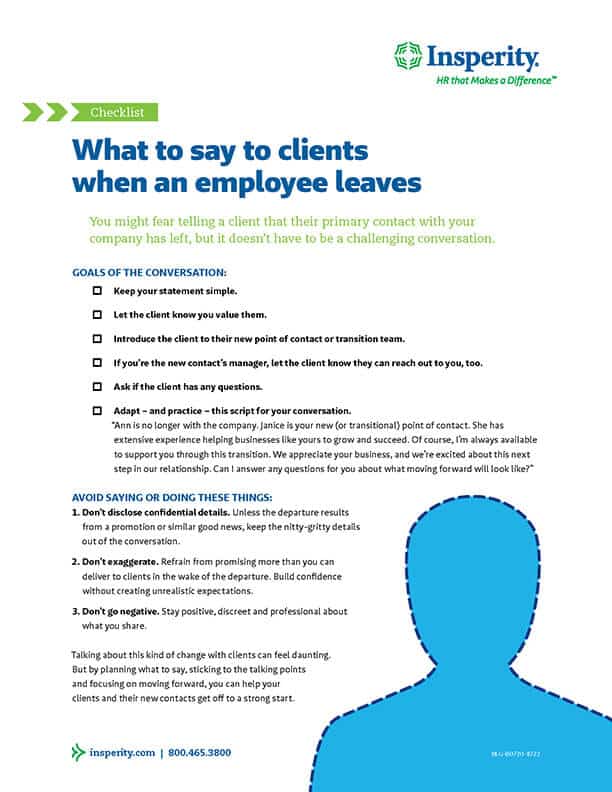Whenever an employee leaves a position – whether it’s due to layoffs, a promotion, a family move or another reason – managing their departure involves more than just collecting their keys and laptop. After you’ve ticked the last box on the employee exit checklist, there’s one more important group of people whom you need to address: clients.
Announcing the resignation of an employee to your clients can feel like a challenging conversation to have. But if you plan your talk in advance, keep it brief and focus on moving forward, you can use the discussion to strengthen the relationship you have with your customers.
Let’s take a closer look at how to prepare for and inform a client about the resignation of an employee.
Checklist: What to tell clients when an employee leaves
You might fear telling a client when an employee has left. If you plan, stick to the script and focus on the future, it doesn’t have to be a difficult conversation.

Checklist: What to tell clients when an employee leaves
You might fear telling a client when an employee has left. If you plan, stick to the script and focus on the future, it doesn’t have to be a difficult conversation.
1. Plan your employee departure announcement in advance.
This is a conversation that you should prepare for. Think through what you want to say and what you don’t want to say. Spend time rehearsing, if necessary, to boost confidence – especially if the departure was sudden or dramatic.
In general, it’s wise to stick to something straightforward: “James is no longer with the company. We look forward to introducing you to your new contact, Jane, who has 12 years of experience serving clients in your industry. We’re excited about continuing to deliver the high level of service your company deserves.”
The goal is to focus the conversation on next steps and the future, while avoiding discussion of any sensitive or personal information about the former employee.
The discussion isn’t the only aspect of the transition you’ll want to plan carefully. Preparing internally for the transition – such as by choosing new points of contact for your clients before the conversation – can help you give your clients the best possible experience.
2. Give clients advance notice.
If you have advance notice of an employee’s upcoming departure, tell the clients who’ll be affected as soon as possible. Let them know:
- The employee’s last day
- Who will be their new point of contact
- How the handoff to the new employee will happen
- Who they can contact if they have questions or need extra help
Be sure to let these clients know that your company’s ongoing commitment to responsiveness and client satisfaction has not changed. Giving clients a heads-up far enough out can reduce concerns that might lead them to bolt. It may also help prevent departing employees from poaching those clients if they’re leaving to work for a competitor.
If the change is for positive reasons, like a promotion within the company, let clients in on the good news. That kind of circumstance puts the transition in a more positive light, especially if your customers have built a relationship with the employee who’s leaving. When appropriate, consider including the outgoing employee in the conversation.
If the employee is leaving for any other reason, you’ll want to stick to the facts, keep the conversation brief and move on to other matters.
3. Review accounts in danger of walking.
Any change can prompt clients to reevaluate their relationship with your company. If you’re concerned that some of the departing employee’s accounts may leave because of the transition, you can:
- Review the accounts that were assigned to this person, evaluating the flight-risk level for each.
- Notify all of the clients in writing, but first ask to meet with those you think may be more apt to bolt.
- Tap into your relationships with key decision makers as needed to explain your plan to serve them moving forward.
4. Assign transition support.
You may need to divide the departing employee’s accounts among your remaining staff. For major accounts – and if you can’t assign a new account person immediately, name a manager or experienced individual as the main point of contact for the affected clients.
For smaller but long-term or high-value customers, you’ll want to assign your most qualified team members. You want these clients to feel like they’re a top priority.
Depending on the services your company provides, you may want to assign a subject matter expert to high-value accounts, too. That can be especially reassuring to the client if it’s going to take a month or longer to assign a new permanent contact person.
Once you have your transition team for each client, brief them on client details, such as:
- Communication preferences
- Major deadlines promised
- The history of the relationship
Instruct the transition team to reassure the client of your company’s commitment to quality and responsiveness. Tell them to back up verbal reassurance with actions that support it.
5. Outline the transition plan.
Ideally, your company has a plan in place before someone leaves, so you’re not in reactive mode when an employee departs.
Regardless of when you create your transition plan, however, it should outline responsibilities and how quickly you want things to happen. There should also be a timeline for relevant internal and client meetings, with a focus on upcoming major deadlines. It’s also wise to include any procedural changes that will happen as part of the transition.
6. Meet with your clients.
Set up a time to meet face to face, virtually or in person, with each client. The goal is not only to let them know about the transition, but also to reestablish relations with your client in a positive way.
It’s helpful to approach them as you would a new client. After all, they’ll be starting a new relationship with a new point of contact.
At the same time, now is a great chance to ask, “What are we doing right, and how can we improve?” You may find there are upsell opportunities or pain points you can relieve.
In addition to listening intently, you can reemphasize the advantages of working with your company. Of course, you should also explain the steps you’re taking to ensure they’re in good hands during the transition.
7. Introduce the replacement.
When’s the best time to introduce a replacement employee to a client? If you already have someone ready to go, you can make the introduction during the meeting when you make the employee departure announcement to your clients. This can reassure the client, especially if their new liaison is a familiar face.
If you’re using a temporary transition team, set up a meeting with the client as soon as you select a permanent point of contact. Regardless of when you make the introduction, use the meeting to talk about how the new employee’s experience and unique qualities will benefit the client.
8. Overdeliver.
Change, even positive change, can unsettle clients and cause some stress. To make the experience as positive as possible, aim to deliver more than your clients expect or request during the transition – especially if the client mentions ways your company could improve, or how they’ll be inconvenienced by the change.
How can you overdeliver? You might decide to:
- Meet a deadline early.
- Provide a complimentary report.
- Offer an unexpected discount.
Overdelivering is a way to show clients that you keep your promises, value their business and are still the best option for them.
9. Consider a team philosophy.
Going forward, you may want to adopt a team approach to servicing accounts. Giving clients more than one trusted point of contact can stress-proof the transition when a client-facing employee leaves.
For example, consider restructuring so that there’s a main point of contact with one or two other backup team members. These “backups” can substitute for the main contact on vacation, sick days or parental leave, and offer the added bonus of getting your team cross-trained on other accounts.
Best of all, a team approach to account management can reassure your clients that they’ll be taken care of, even when some of the players change.
Sample email to clients about an employee leaving
Breaking the news to your clients about an employee’s resignation can be difficult. Here is an example of how you can compose a staff resignation announcement email to your client:
Subject line: A difficult announcement — [EMPLOYEE] is leaving the company
Dear [CLIENT],
I’m writing with a combination of sadness and pride to let you know [OUTGOING EMPLOYEE] is leaving our company, effective [DATE].
Although we’re sorry to lose [OUTGOING EMPLOYEE]’s skills and dedication to serving you, we hope you’ll join us in wishing [OUTGOING EMPLOYEE] all the success in the world as [HE/SHE] moves to a new opportunity elsewhere.
We are assigning [EMPLOYEE] to your account, and we’re confident that [HE/SHE] will continue to provide the service and professionalism you’ve come to expect from us. [HE/SHE] has all the experience and expertise necessary to ensure a seamless transition for you and your account. [HE/SHE] can be reached at [PHONE/EMAIL] if you have any questions.
[OUTGOING EMPLOYEE] is working closely with [EMPLOYEE] to ensure [HE/SHE] understands your account and how best to serve your needs. We’re confident [EMPLOYEE] will hit the ground running and continue the experience you’ve had with [OUTGOING EMPLOYEE] up to this point.
Please reach out to me if you have any questions or concerns as we go through this transition together. We value your business and look forward to maintaining our relationship well into the future.
Sincerely,
[NAME]
Want more advice on how to make the people side of your business run smoother — like how to handle an employee departure announcement to clients? Download and read our free e-book: How to develop a top-notch workforce that will accelerate your business.

Checklist: What to tell clients when an employee leaves
You might fear telling a client when an employee has left. If you plan, stick to the script and focus on the future, it doesn’t have to be a difficult conversation.


